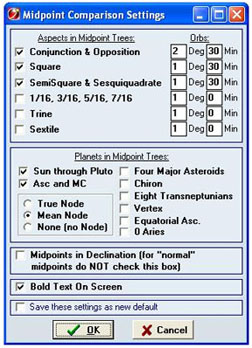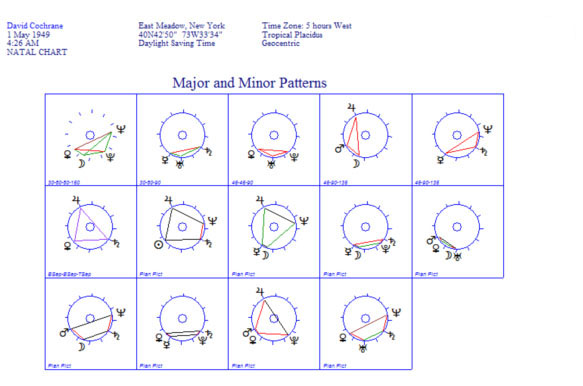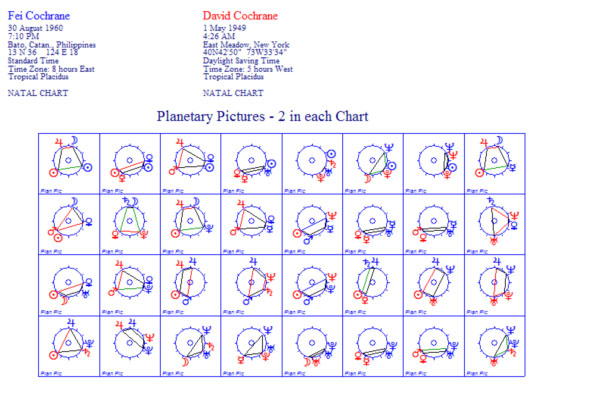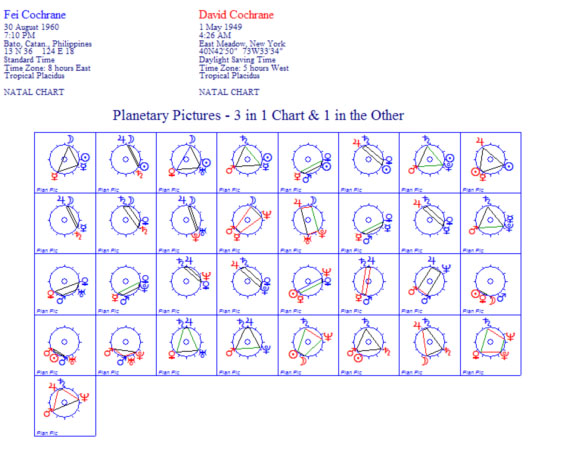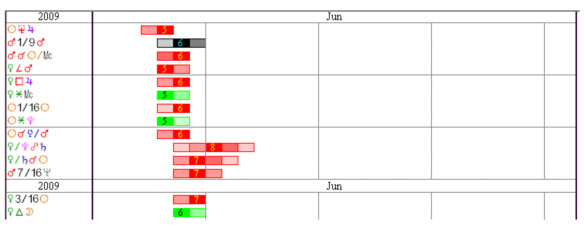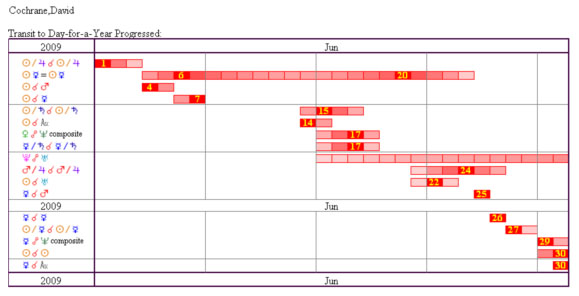|
Below are briefly summarized some of main Uranian astrology and symmetrical astrology features in Sirius 1.0. There are also additional features that are not mentioned. The description below, however, does provide a good overall view of the features that are available. We have also mentioned which of these features are in Kepler 7. Note that future versions of Sirius and Kepler are likely to have more features. |
| Introduction to Uranian Astrology and Symmetrical Astrology Uranian astrology, also known as the Hamburg School, was developed by Alfred Witte and his colleagues. Some of the main features of this approach to astrological interpretation are the use of planetary pictures, midpoint structures, and the 8 hypothetical transneptunians. One of the main tools used by Witte and his colleagues are dials. Also, the graphic ephemeris popularized by Reinhold Ebertin in cosmobiology is used by many Uranian astrologers. The term “symmetrical astrology” is a newer term that is applied to an emphasis on the use of planetary pictures, direct midpoint structures, and other configurations that exhibit symmetrical qualities. As Witte’s ideas have become applied to other areas such as AstroLocality, and the relationship of planetary pictures to other theoretical concepts such as composite charts and arabic parts (as explained below), and also as new tools have been developed to complement or to replace the use of dials, Uranian astrology has evolved for some astrologers in ways beyond those originally formulated by Witte and his colleagues. The term “symmetrical astrology” for this broader and more modern application of principles articulated by the early Uranian astrologers helps distinguish these progressive developments from the doctrines established by Witte and his colleagues. In the description of features below we refer to them as features of “symmetrical astrology” as this term tends to include any features related to the use of techniques introduced or emphasized in Uranian astrology but applied to a broad range of areas and utilizing additional tools to the dials and other tools that were the mainstay in the early development of Uranian astrology. An accelerated development of computerized astrological calculations began in the early 1980’s as home computers at reasonably affordable prices became available. Software development from Cosmic Patterns Software and other astrology software companies has continued at an intense pace since then and astrological software continues to improve at a fairly fast pace. The description of features below is of Sirius 1.0 and future versions will have improved features. Symmetrical Astrology Features of Sirius The following
descriptions are very brief: 1. Midpoint Structures In the Birth Chart and Between Charts: Shown below is a screen for selecting settings for compatibility midpoints. You can see some of the options, such as doing midpoints in declination (one of the early concepts developed but not used very often by modern astrologers). Shown below is a section of the midpoint structures displayed (the report continues; we are showing just the first few lines):
2. Planetary Pictures in the Birth Chart and Between Charts: Shown below are harmonic patterns and planetary pictures in a birth chart. You can customize the settings to remove the harmonic patterns if you do not wish to include them.
You can also display planetary patterns formed between two charts. Shown below are planetary pictures formed by two planets in one chart and two planets in the other chart. The names are color coded to indicate which planets are from which chart.
Shown below are planetary pictures formed by 3 planets in one chart and 1 planet in the other chart.
3. Transiting and Progressed Midpoint Structures: Both Kepler and Sirius can produce midpoint structures formed between a transiting planet and natal midpoint, and also from progressed-to-natal, progressed-to-progressed, and transit-to-progressed. Both planet-to-midpoint and midpoint-to-planet midpoint structures can be viewed. In the section of the Time Line format shown below transiting Sun is conjunct secondary progressed Venus/Pluto midpoint on 6 June 2009, and transiting Venus/Saturn midpoint is conjunct progressed Sun on 7 June 2009.
4. Transiting and Progressed Planetary Pictures: In Sirius, but not in Kepler 7, you can also display transiting and progressed planetary pictures formed by two transiting (or progressed) planets and two natal planets in the Time Line Format. This feature is available only in Time Line Format, and not in the text listing format. There are an enormous number of planetary pictures forming at any time because there are an enormous number of possible planetary pictures even if the 8 hypothetical transneptunians are not included. The amount of information can consequently be overwhelming. Of particular interest to some astrologers among these planetary pictures are those planetary pictures formed by the same two planets in each chart. For example, a planetary picture might be formed by transiting Sun and Moon to your natal Sun and Moon (as opposed to, for example, transiting Sun and Moon making a planetary picture with your natal Mars and Jupiter or to your natal Sun and Mercury). Although not discussed often in Uranian and symmetrical astrology and perhaps not widely known, there are 3 ways in which the same two planets from two charts (such as a transiting and natal charts for example) can combine together to form a planetary picture: (1) Midpoint-Midpoint, (2) Same Angle, and (3) Composite Chart Alignment. In Time Line Format you can select all planetary pictures or only those involving the same planets and you can select any of these three kinds planetary pictures involving these planets. Shown below are planetary pictures formed between the transits
The first influence displayed shows that the transiting Sun/Jupiter midpoint is conjunct the progressed Sun/Jupiter midpoint on 1 June 2009. The next influence shows that the transiting Sun-Mercury angle is the same as the progressed Sun-Mercury angle on 6 June 2009 and 20 June 2009 and it is in orb from 4 June 2009 to 24 June 2009. The 7th influence in the listing shows the third kind of planetary picture that can form between the same two planets: an opposition of Venus and Neptune in the composite chart of the transiting planets and progressed planets.
This feature of Sirius allows you to easily see the most important planetary pictures being formed between transiting and natal planets, or between progressed and natal planets, or as shown above beween transiting and progressed planets. The ability to obtained this detailed and specific information in a very easy-to-read format makes it possible for many astrologers to see astrological influences based on the principles of symmetrical astrology and Uranian astrology much more easily than was possible before. If you would like to read more about these especially important planetary pictures you can read the article at http://astrosoftware.com/Symmetries.htm 5. AstroMaps, AstroSignature Forecast Graph, Research: The 8 transneptunians and midpoint structures are available in many parts of the Kepler and Sirius programs. For example, you can place midpoint lines in AstroMaps, include midpoint structures in the AstroSignature Forecast Graph, and do research on midpoint structures in the research section of Kepler and Sirius. Most of these features are in both Kepler and Sirius, but there are some features, such as an exploratory feature that displays what midpoint-to-midpoint patterns appear most often in a group of charts that is available only in Sirius. Also some features are more easily customized in Sirius than in Kepler. For example, when customizing a 90 Degree Dial wheel or when customizing the planets, aspects, and other selections in Sirius, the screens have been improved by making them simpler, sharper, and easier to navigate through. There is no end to software development, whether it is in adding features or improving the ability to customize features, and there are many small improvements throughout Sirius that in total make a big difference. Kepler is very easy to use and very intuitive and Sirius uses the same simple layout and concepts, but improvements have been made throughout the program. 6. Graphic Ephemeris: The Graphic Ephemeris in Kepler is very flexible, allowing you to place natal, transiting, and progressed planets in the graphic ephemeris. You can select more than one natal chart, a return chart, more than one progressed chart, etc. Some of the new features of Sirius are the ability to place midpoint lines, lines that indicate the angular distance between planets, and asteroids in the graphic ephemeris. Click on this link to see some samples of the graphic ephemeris in Kepler: http://astrosoftware.com/GraphicEphemeris.htm There are new format options in Sirius and some additional features but the samples of the graphic ephemeris that you see by clicking on this link also give you some idea of what the graphic ephemeris looks like in Sirius as well. 7. Interactive 90 Degree Dials (or 45-degree, etc.): Dials are an important too for Uranian astrologers. When astrologers and students of astrology learn about dials they typically they wonder why one would wish to spin a dial to see midpoint structures when one can obtain midpoint tree diagrams and see precisely when midpoint structures are starting, are exact, and end in the Time Line Format. However, when Uranian astrology was developed, these software tools were not available and some astrologers have become very adept at using dials and find them to be very useful. For these astrologers we have included the interactive 90 degree dial. Shown below is a screen capture of an interactive 90 Degree TriWheel dial in Sirius:
On the panel on the right side you can move the chart forward or backward in time, select a different progressed chart, switch between a TriWheel and 3 Separte wheels, and select a few other things as well. In the center of the TriWheel you can grab the arrow and rotate it to point it to different points on the dial and display the midpoint structures formed in each of the 3 charts. There is also an interactive dial of a single chart, two charts (natal and transits or natal and progressed, and 4 charts (natal, progressed, return, and transits or of a natal chart, 2 progressions, and transits). 8. Other
Uranian and Symmetrical Astrology Features: It is possible
that we have not thought of some other important feature related to symmetrical
astrology while assembling this information for this article. If there
is an feature that is important to you and we did not mention it, you
can verify with us as to whether it is available in Sirius. If not, we
appreciate hearing from you as this helps us know what features users
(or potential future users if you do not already own Kepler or Sirius)
wish us add in the future. |
![]()

![]()

